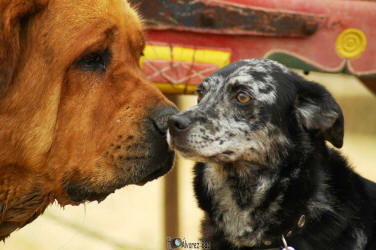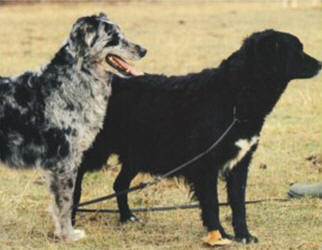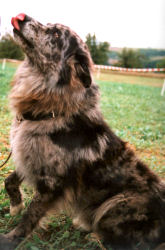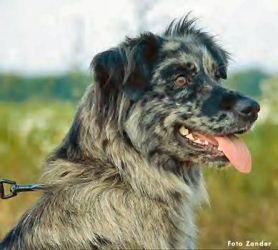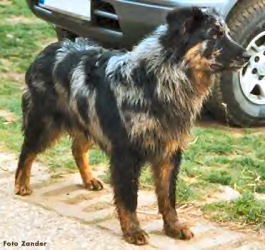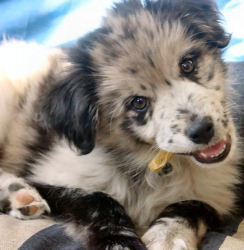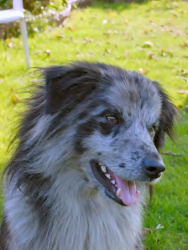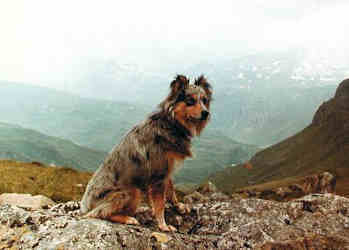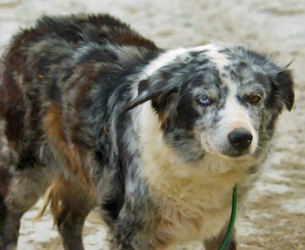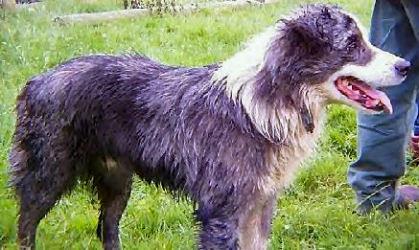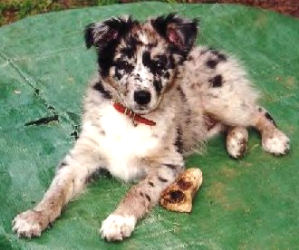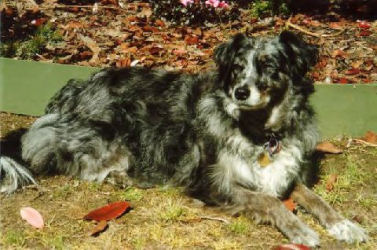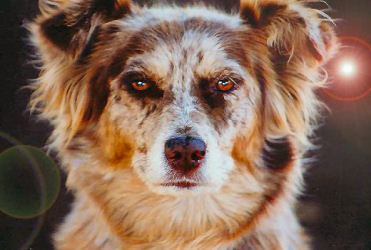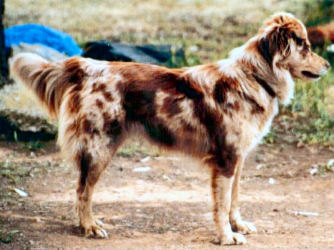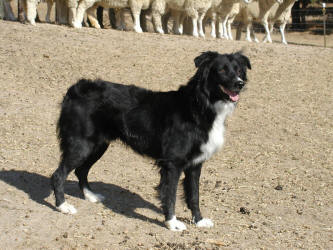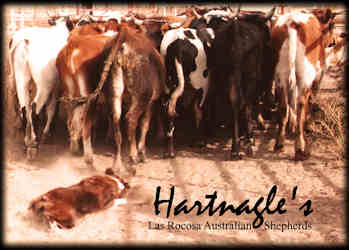 |
|||||||||||||||
|
Education: Books, Videos & Herding Clinics
|
Chapter I: The Australian Shepherd and Breeds From a Common Root
When Spain colonized America, they introduced two kinds of sheep — Churras (Churros) and Merinos (known for their exceptionally fine wool and fleece). Spaniards brought Churras in large numbers to provide food and fiber. The flocks not only survived in their new environment, but they flourished and multiplied. The dogs, too, were hardy individuals, toughened by exposure, and they proved to be capable of withstanding many hardships in the rough, dangerous, and uncharted lands of the Southwest.
The Spanish Churra is an ancient indigenous breed raised throughout the plateaus and sierras of Castile and León. This region in north-western Spain is also where the enormous flocks of Merino sheep were trailed each spring to graze in the mountains during summer since the Middle Ages. In the autumn, around October — the shepherds began their trek back to their winter pastures in the south on the plains of Estremadura and Andalusia. It is estimated that thousands of dogs accompanied them, the smaller ones for tending the flock (Carea) and the larger for guarding (Mastín).
Each massive flock or cabaña numbered around 50,000 sheep would be divided into smaller bands averaging 1,000 head. The droves of sheep were tended by shepherds and their dogs. Traditionally, two herders, four dogs and a pack-horse or mule were employed for every 1,000 sheep. The mules were used to pack salt for the sheep, cooking utensils, food for the shepherds and the dogs, and any lamb that was born during the journey and was too young to endure the hardships of migration.
Recognizing they could be replaced or absorbed by other breeds and lost forever — a recovery program was put in place through the University of Leon in cooperation with the Leonese Canine Society. The Carea Leonés is making a comeback.
Careas are reserved with strangers. They are hardy, tough and versatile working dogs with strong herding and guardian instincts (a characteristic still seen in Australian Shepherds today). They are highly capable of handling sheep or cattle and are sought after by herdsmen. Their working style is based on the type of work needed when grazing their livestock in cultivated areas unlike when flocks and herds are pastured on mountain zones and allowed to graze freely. They keep the animals in check in the same way shepherds in other parts of Europe do as they lead their flocks out to graze. They would not be able to manage stock without them as they have throughout the ages.
The Carea Leonés is approximately 18 inches (48cm) to 22 inches (55cm) tall. Their coat is either solid black, liver red or merle (arlequinados or “pintos”) with or without white and or tan trim (shepherds spots) and is a moderate length. The Spanish herding dogs in California and the Southwest have always been known and used by early breeders. For example, Maryland Little’s Honey Bun was considered “the Spanish type.” She was from the Graatz ranch in Colton, California with several recorded generations preceding her. Maryland based her breeding program on both Basque and Spanish dogs.
While the Spanish Merino was developed in Spain – Saxony Merinos - the Ramboullet is a strain that originated from Merino sheep taken from Spain in the 1700s across the Pyrenees Mountains to Germany and then later on to Australia with German settlers.
Eliza Forlonge who is considered to be the mother of the Australian Fine Wool Industry, made several walking journeys (averaging 10 to 12 miles a day) throughout Germany and one to the top Merino breeding farm in Rambouillet France. On her journeys she purchased the finest sheep she could find. Later, she retraced her journey, collected the sheep and drove them to be shipped to New South Wales Australia.
In 1796, John and Elizabeth Macarthur, pioneers and founders of the Australian Wool Industry imported their first flock of Spanish Merino sheep. The Merinos thrived in Australia because the dry, hot climate was very comparable to Spain’s. Records indicate in 1825, Elizabeth transported Joseph Pabts, a German to New South Wales to care for her flocks. It has also been suggested that when he arrived he brought German herding dogs with him, very possibly a strain of Old German Shepherds (Altdeutscher Schaferhund) known as Tigers. Tigers are primarily found in southern Germany and look like old foundation working Aussies. The shepherds (stockmen) referred to them simply as sheepdogs. No different than ranchers here who call their stockdogs regardless of the breed: cowdogs or sheepdogs. Arbeitsgemeinschaft zur Zucht Altdeutsche Hutehunde (A-A-H) was developed by a group of shsepherds for the preservation and registration of the old German herding strains that were in danger of extinction.
And yes, some of these blue dogs accompanied boatloads of sheep to America from Australia hence the name we know the breed by. Other little blue dogs such as Ely’s Feo, one of the first dogs registered as an Australian Shepherd (forming the foundation of the breed) came directly from the little country of Andorra in the Pyrenees Mountains (between Spain and France) and arrived in the United States when Basque sheepherders were imported by the Western Range Association to ease the acute labour shortage felt by the sheep industry at the end of WWII. See also: Vanished Trails and Faded Memories of Australian Shepherd History
Each region of the Pyrenees (often remote from one another) developed sheepdogs that best suited the needs of the people in the valley where they were used. It was difficult to trace the exact origin of the breed, because the Basques had no written language. Many could not speak English, and their language was neither French nor Spanish. This was long before the time of the Internet.
While the Australian Shepherd bears resemblance to the blue merle, smooth faced or “Face Rase” Berger des Pyrenees, better known in English speaking countries as the Pyrenean Shepherd, breed fanciers are often confused by modern representatives of the usually shaggy coated breed; and the lack of certain traits in Pyrenean Shepherds such as tan or copper trim. In 1920s, a Breed Standard for Pyrenean Shepherds was developed by a famous show judge in France. For whatever reason, he decided traits such as tan trim were frowned on, thus discouraged and bred away from. Furthermore, the a^y gene that produces sable (black tipped tan) color of the hair coat commonly associated with Pyrenean Shepherds is dominant to the a^t gene that produces tan trim, so it would not be produced thus purged from the genetic makeup.
Modern representatives don’t necessarily reflect the diversity that once existed and has been greatly reduced through the years of development. Not unlike modern Australian Shepherds that the general public has become familiar with through dog shows. Many of these dogs (as superior as they may) do not necessarily expose the original types that contributed to the breed’s formation and development. In order to see the connections you have to look at the early foundation dogs at the beginning of either breed.
Smooth-faced Pyrenean Sheepdogs have always existed, but most people are familiar with the long hair variety. French breeders describe them as “Less nervous and more biddable than their shaggy cousin”. Natural bobtails (of varying lengths) do occur in some bloodlines. Occasionally puppies with white trim are produced, but not exhibited in the breed ring as white trim is faulted as is the copper (tan) trim. The type of Basque shepherd that once herded sheep across the American West can still be found in remote regions of the Pyrenees Mountains, but very rarely in the show ring. According to Bernard Sénac-Lagrange, Vice-President of the French Kennel Club– the smooth-faced variety of Pyrenean Sheepdog was principally found in the Pyrenean foot-hills where it was “much appreciated by horse-dealers and cattle-drovers.” Its distinctive features compared with those of other types of Pyrenean Sheepdogs gained it an appendix in the breed standard from the 1920s. An example of this is Mab du Hic a ‘grey-harlekin face rase’ with tan, world champion bred by Robert Perrot living in Saint-Maure France in the 70s.
It is a commonly accepted that ancestors of colley dogs (collies) accompanied the ancient people of northern Spain, the Iberians who migrated to the British Isles. According to Herding Dogs Their Origins and Development in Britain, “From customs records it appears that a few sheepdogs arrived in Ireland with the Merino sheep from Spain and Portugal in the early part of the eighteenth century. The sheep from that area were being exported all over the world to effect improvement in local breeds, etc.”
In the same book, the author, Iris Combe mentions the Iberian strain, “as it was known, and which is thought by some to have been brought to the Irish monastery farms by monks returning from Spain to Portugal, etc….” She also points out that Ireland and Wales were landing places for priests who came from France and Spain centuries ago.
Those old Welsh farm dogs that strongly resembled early Australian Shepherds in both type and temperament almost died out. In 1997, The Welsh Sheepdog Society (Cymdeithas Cwn Cymreig) was formed to register and protect the indigenous Welsh sheepdogs from becoming absorbed by Border Collies and to preserve the role of the breed in livestock farming. They have been described as being adaptable in their work and are good watch dogs, barking at intruders, but normally good with children. “They have a natural instinct for stock work and are capable of using their own initiative as well as being directed, which makes them very useful when working big groups of sheep in open country. They will spring to flush sheep from rocks or undergrowth and have tremendous agility and stamina.”
This beautiful 18 year old Welsh Sheepdog is a testimony to the breed's
longevity.
“Equally at home in enclosed land or in the handling pens, they will bark strongly if necessary and some will run across the backs of sheep if they become jammed. A strong dog can catch and hold a hill ewe at command; most will catch a lamb for treatment. They have immense courage – a good Welsh dog weighing in at about 20kg can easily turn a 750 kg cow)”.
These dogs were taken to Australia with Welsh settlers and are believed to have contributed to the origin of Australian Koolies, formerly known as German Koolies (or Coolies); one of Australia’s oldest working breeds appearing in the middle 1800s in New South Wales. In 1911, Robert Kaleski, who wrote the original breed standard for Australian Cattle Dogs said “at this time there are many varieties of working dogs. One particular one called the Welsh Heeler or Merle is commonly referred to as the German Koolie.”
According to early Koolie owners, “they were highly adaptable and would work in all terrain and weather until they dropped just for the shear love of working, yet at the day’s end were still devoted companions. They were bred for what was needed at the time. Truck and transport workers required a small agile hardy dog that could move quickly and work hard. For paddock work on the station or for droving they wanted a dog that could eat up the distances and have great stamina with a shorter coat to keep off the burrs. In the snowy high country double coated dogs with a soft, water resistant undercoat were better suited to keep out the chill. In the north, stockmen handling semi-wild cattle sought a well-built dog with strength needed for the job.”
Koolies almost vanished in the same way, Old German Tigers, and Old Welsh Sheepdogs were difficult if not almost impossible to locate. They became almost extinct. They were nowhere to be found, so many Koolies were simply bred to other good working dogs. Consequently, Koolies are a diverse group with smooth, short or medium length coats and a variety of ear sets to match. In 2000, the Koolie Club of Australia (KCA) was formed to safeguard and promote the breed and maintain their integrity as a stockdog “gently working dairy cows or fronting up to scrub cattle” to put it in Aussie jargon.
Australia (KCA) was formed to safeguard and promote the breed and maintain their integrity as a stockdog “gently working dairy cows or fronting up to scrub cattle” to put it in Aussie jargon.
Even though it is an old breed, it is a breed in its infancy.
Currently, the club has implemented a DNA program to document parentage and
genetics for future generations. Members are also researching the breed’s past
through the sheep industry and stockmen whose livelihood depended on them. Much
is yet to be discovered before the final story can be written about the
Australian Koolie, but the pieces are slowly coming together.
Las Rocosa Ritchie OTDc, a true working Australian Shepherd
Copyright ©2010 by Jeanne Joy Hartnagle-Taylor. All Rights Reserved. No part of the material covered by this copyright may be reproduced in any form without written permission from the author.
|
||||||||||||||
